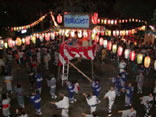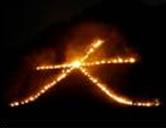Annual Events in Japan
August: Obon
Obon is an abbreviation of Urabone and is a festival honoring people's ancestors. The dates of Obon vary depending upon the region, but generally are from August 13 to August 16. It is a very important festival in Japan, much like Oshogatsu. On the first day of Obon, August 13th, is known as 'Mukaebon.' On this day, the spirits of people's ancestors are welcomed back from the world of the dead. The last day of Obon, August 16th, is known as 'Okuribon.' This is the day that the spirits return to heaven.
The Origins of Urabone
Urabone originates in the story of Urabonkyo by Maudgalyayana, one of Sakyamuni Buddha's closest disciples. Maudgalyayana's mother died and went to hell. When he asked Sakyamuni Buddha how he could save her, he replied "The fifteenth day of July is when the hundred days of ascetic practice ends for priests. Offer food to the priests and hold a memorial service." Maudgalyayana did as he was told and his mother was saved from her torments. This is how Urabone, the memorial for one's dead ancestors, came to be.
How do people prepare for Obon?
As Obon approaches, people typically purify the family altar. When Obon begins, they then create and decorate a shelf for spirits. On the shelf are placed a cucumber and an eggplant, each with four legs made from chopsticks. The cucumber represents a horse and is offered for the deceased to ride home. The eggplant represents an ox and is offered to carry the deceased's belongings back.
The Origins of the Bon-odori (The Obon Dance)

Bonodori is a representative summer festival and was originally a Buddhist event. The Buddhist Prayer Dance, which began in the Heian period, combined with Obon and became a festival to welcome and console returning spirits. Bonodori is just one of the things that people associate with summer.
Welcome and Farewell Fires

The welcome fire (mukaebi) is lit on the evening of August 13 in front of the home to keep the returning spirits from losing their way. The farewell fire (okuribi) is lit in the same place and the spirits return to their graves. This practice has continued since the Edogawa period and, on the mountain of Daimonja in Kyoto, a huge '大' (the Chinese character for 'big') is lit as a farewell fire.





 Japan
Japan 한국어
한국어 简体字
简体字 繁体字
繁体字 English
English













